Understanding Shark Radar: Enhancing Ocean Safety for Surfers

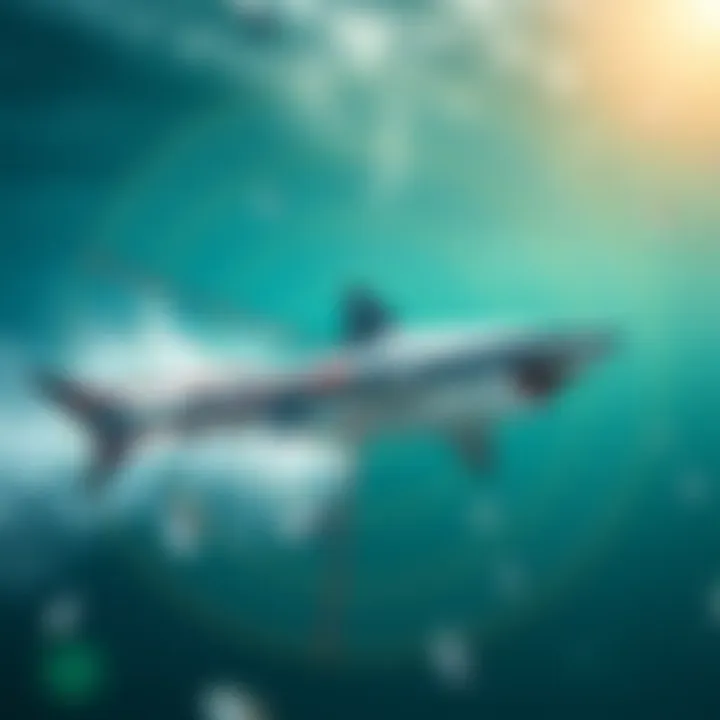
Intro
As surfers venture into the vastness of the ocean, they encounter numerous elements—waves, wind, and, quite crucially, marine life. Among these creatures, sharks hold a particular fascination and fear. The emergence of shark radar technology has piqued interest within the surfing community, promising both excitement and safety. Understanding this technology allows surfers to navigate the waters with a bit more awareness and confidence. In this exploration, we will delve into the mechanics behind shark detection systems, their evolution, and implications for those who love to hang ten.
Surfboard Technology
Innovations in Surfboard Materials
Surfboards have come a long way since the days of redwood planks. Nowadays, technology infuses creativity and science, leading to lighter, more durable boards. One popular material is epoxy, which offers better buoyancy and resistance to dings compared to traditional polyurethane. Moreover, boards crafted with recycled materials not only cater to performance but also aim for sustainability in a world increasingly aware of environmental concerns.
Using carbon fiber is a game changer, allowing boards to maintain structural integrity while reducing overall weight. You might find that a board made with these materials glides more effortlessly across waves, enhancing performance.
Comparing Different Surfboard Shapes
Not all surfboards are created equal. The shape of a board can dramatically alter the riding experience. For instance, shortboards are often favored for their agility, making them ideal for trick-heavy surfing. In contrast, longboards provide stability, allowing a more relaxed ride, perfect for novice surfers or those who want to cruise along the waves.
Here’s a breakdown:
- Shortboards: Great for maneuvers; typically under six feet in length.
- Longboards: Provide greater stability and easier paddling; generally over nine feet.
- Fish: Wider, shorter boards that excel in small to medium waves, offering a unique ride.
- Funboards: A hybrid of short and longboards, these are versatile, catering to a range of skills.
Understanding these shapes helps surfers select the right board for their style and comfort level.
Shark Radar Technology
The Mechanics Behind Shark Detection
Shark radar systems utilize sonar technology that waves sound waves to detect the presence of sharks in nearby waters. These systems can differentiate shark shapes from other marine life, greatly enhancing the safety of surfers. They generally operate based on echolocation principles—like sending out a ping and waiting for the echoes to return. If a shark swims within a specified range, the system relays this crucial information to surfers in real-time.
Such advancements have evolved from simple observation protocols to sophisticated tracking devices. The integration of satellite technology means that surfers can also receive alerts on their mobile phones if a shark is detected in their vicinity.
"Shark radar technology could turn the tide in ocean safety, allowing surfers to enjoy waves without the lurking fear of marine encounters."
Applications of Shark Radar
These systems have applications beyond simply alerting surfers. Beaches increasingly utilize shark radar to monitor marine activity, ensuring safe swimming zones. By combining shark detection with educational programs, the surfing community gains insight into local marine life and ecosystem balance.
Furthermore, these technologies contribute to data collection for scientific research. This data can help researchers understand shark behavior better and engage in more informed conservation efforts.
Awareness and Education
Understanding the ocean and its inhabitants is crucial for surfers. Shark radar technology not only provides a layer of safety but also fosters a deeper connection with the marine environment. Surfers are encouraged to participate in educational initiatives, such as workshops and community discussions, which can enlighten them about coexistence with marine life and how to react appropriately in potential encounters.
In summary, as innovation breathes new life into surfing culture, shark radar represents a blending of technology and environmental consciousness, enhancing safety in an exhilarating sport where nature reigns supreme. All in all, it’s quite a wave to ride, knowing you’ve got a little extra help watching your back on those big days at the beach.
Prologue to Shark Radar Technology
Shark radar technology is a paramount advancement in both marine safety and the surfing community. Its importance cannot be overstated, as it bridges the gap between our love for the ocean and the need for safety in potentially dangerous situations. With increasing interactions between surfers and larger marine life, understanding this technology is critical for enhancing safety measures and making informed decisions on the water.
This section aims to dissect the fundamental aspects of shark radar, shedding light on how it operates, its historical development, and its relevance in present-day aquatic environments. By diving into this subject, we can illuminate the critical benefits that such technology offers, not just to surfers but also to educational programs that raise awareness about our interaction with the natural world.
Defining Shark Radar
Shark radar essentially encompasses a range of technologies designed to detect and monitor shark movements in specified coastal areas. The core principle is to use sonar, infrared, and other sensing techniques to allow real-time tracking, alerting surfers about the presence of sharks nearby. The overall aim? To provide safety warnings and reduce the risk of shark-related incidents. It’s not just a complex gadget; rather, it represents a lifeline for those who thrive on the waves, keeping communities informed and enabled to enjoy their ocean pursuits more securely.
Shark radar systems use various sensors and technologies such as aerial drones, underwater buoys, and even sophisticated cameras that analyze patterns and zones frequented by sharks. By creating zones of surveillance, these systems allow for real-time updates and alerts, enabling surfers to take precautionary measures.
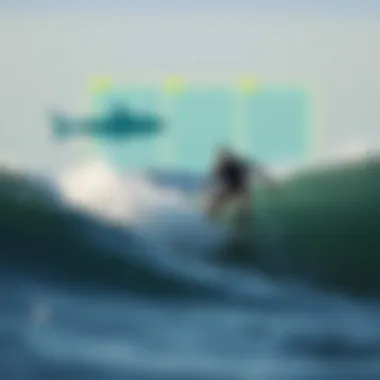
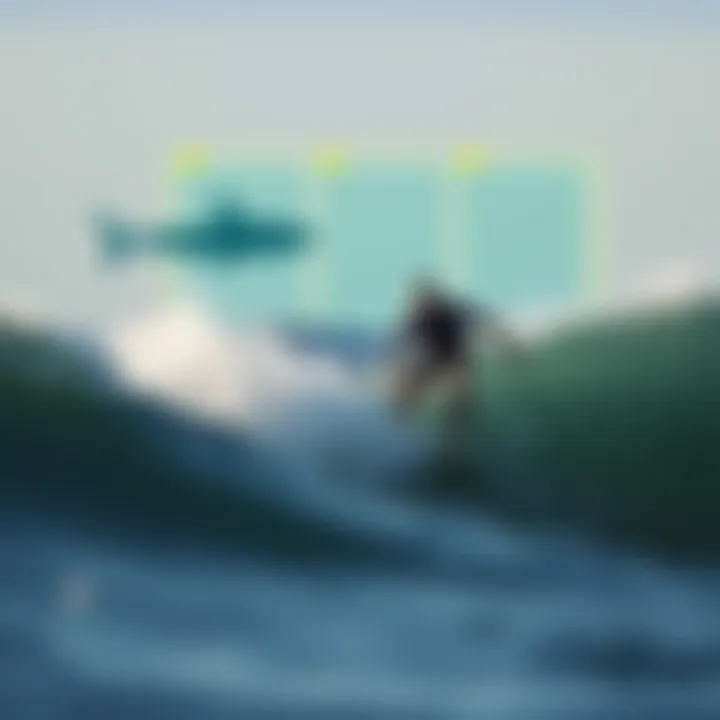
The Evolution of Shark Detection
Shark detection has come a long way since the rudimentary methods utilized in the past. Decades ago, shark sightings were primarily reliant on visual identification or reports by other surfers. As technology has progressed, so has our understanding and means to detect these magnificent creatures efficiently.
In the early 2000s, various surf spots around the world began experimenting with basic sonar systems, leading to a gradual shift toward more advanced methods. Today, we have more sophisticated shark detection systems that do not only rely on human observers.
- Historical Systems: Initially, simple nets and drum lines were employed to catch sharks, often proving detrimental to marine life and the broader ecosystem.
- Technological Innovations: Now we see the integration of satellite tracking and machine learning algorithms processing vast amounts of data to improve detection accuracy.
As these technologies improve, our ability to not only monitor but understand the habits of sharks increases. Thus, fostering an environment where surfers can ride the waves with greater peace of mind. Although challenges remain, the evolution of shark detection efforts underscores a remarkable leap towards understanding and cohabiting with marine life.
Mechanisms Behind Shark Radar
The mechanisms of shark radar are at the crux of understanding how these advanced technologies work to enhance safety in our oceans. This topic dives into the nuts and bolts of shark detection and highlights the benefits, considerations, and implications of such systems. From surfers catching waves to beachgoers enjoying the shoreline, grasping how these technologies function is paramount for fostering a safer marine environment.
Technological Framework
At its core, the technological framework of shark radar combines various sensors and data collection methods. These systems often utilize microwave and ultrasonic waves to detect movement and differentiate between marine life, specifically targeting sharks based on their unique behavioral patterns. Imagine a sonar system, much akin to how dolphins communicate underwater, sending out sound waves that bounce off objects, helping determine their size and distance.
The framework can also incorporate radio-frequency identification (RFID) tags. These are small devices that can be attached to sharks, enabling researchers to track their movements and behaviors in real-time. By understanding where these creatures travel, we can better predict when and where they might come close to swimming areas. Additionally, radar systems can be equipped with advanced cameras and thermal imaging, making it easier to identify sharks even in murky waters.
Key Components of Technological Framework:
- Radio-frequency mechanisms to relay data about shark movements.
- Cameras and imaging systems providing visual recognition in various conditions.
- User-friendly interfaces that allow surfers and lifeguards to interpret data easily.
Sensing Capabilities
The sensing capabilities of shark radar systems are pivotal for effective shark detection. Unlike traditional methods, which might rely on human observation or netting, shark radar offers a continuous and accurate means of monitoring. By employing a mix of Doppler and laser systems, these radars can spot the rapid movement patterns associated with sharks, distinguishing them from other marine animals like dolphins and fish. This specificity allows for timely alerts when sharks approach designated swimming areas.
A vital aspect of these sensing technologies is their ability to gather data across varying environmental conditions. These devices can function in different water qualities—be it crystal clear or muddy—ensuring that no stone is left unturned in the quest for safer waters. The systems are often equipped with algorithms that adjust sensitivity based on real-time feedback, fine-tuning their ability to distinguish between a harmless fish and a dangerous shark.
Advantages of Sensing Capabilities:
- Continuous monitoring, providing peace of mind for surfers and swimmers.
- Adjustable parameters to improve signal clarity in different underwater settings.
- Ability to send immediate alerts through smartphone applications or local alarms, ensuring rapid response.
Data Processing Algorithms
Data processing is where the magic truly happens—transforming raw data into insightful information. Shark radar systems employ sophisticated algorithms to interpret detected signals and produce actionable intelligence. This means that once the radar senses movement, the data is analyzed to determine species, size, and even behavior patterns. The complexity of these algorithms plays a crucial role in minimizing false alarms—that is, alerts triggered by non-threatening sea life.
Researchers and developers continually refine these algorithms to enhance performance. Machine learning techniques have been harnessed to improve detection accuracy over time; as they process more data, they become better at identifying patterns specific to different shark species. Additionally, these algorithms often work on cloud-based platforms, allowing for real-time data sharing across multiple locations, which is particularly useful in surf hotspots like Hawaii and Australia, where shark activity is monitored consistently.
Benefits of Data Processing Algorithms:
- Improved accuracy in detecting various shark species, reducing anxiety for beachgoers.
- Quick data dissemination to local authorities and surf clubs, enabling faster response times in case of a shark sighting.
- Enhanced predictive analytics that can forecast shark movements based on historical data.
"Understanding the mechanisms behind shark radar is not just about technology; it’s about creating a blend of safety and innovation."
In summary, unraveling the mechanisms behind shark radar technology enhances our awareness and preparedness in ocean activities. From the technological framework and its sensing capabilities to the intricate data processing algorithms, every facet plays a role in improving ocean safety. As technology advances, so does our capacity to coexist with the marine creatures that grace our waters.
Applications in Surfing
The advent of shark radar technology holds profound implications for surfers and coastal communities alike. To elaborate, this technology acts as a frontline defense, primarily aimed at ensuring a safer surfing environment. In a world where the ocean is both a playground and a habitat for formidable creatures, understanding how shark radar systems enhance safety and awareness becomes essential for surfers and beachgoers.
One of the significant advantages of shark radar is its role in Safety Monitoring Systems. These systems operate as a sort of lifeguard in the digital age, providing real-time information about shark activity in the vicinity of popular surfing spots. Instant notifications alert surfers to potential risks, allowing for informed decisions about entering the water. The critical aspect here is reducing the anxiety that often accompanies surfing where bites have been reported. Surfers can focus on their stoke rather than fretting about an unseen threat below.
Another key application is found in the Surfer Awareness and Training Programs. With the egregious misunderstandings surrounding shark populations, educational outreach becomes vital. Training programs utilize data gleaned from shark radar technology to inform surfers about sharks' behaviors and migration patterns. Surfers learning about sharks’ natural inclinations and their ecological importance can foster respect and reduce the fear that often leads to panic among ocean users. Knowledge is a powerful tool—equipping surf communities with information can empower them to approach their aquatic adventures with a new mindset.
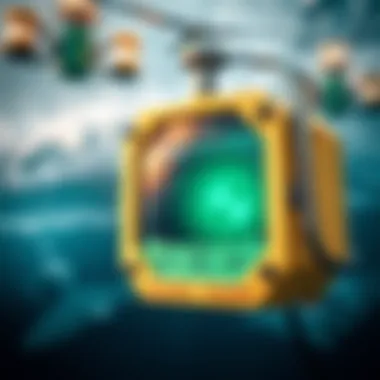
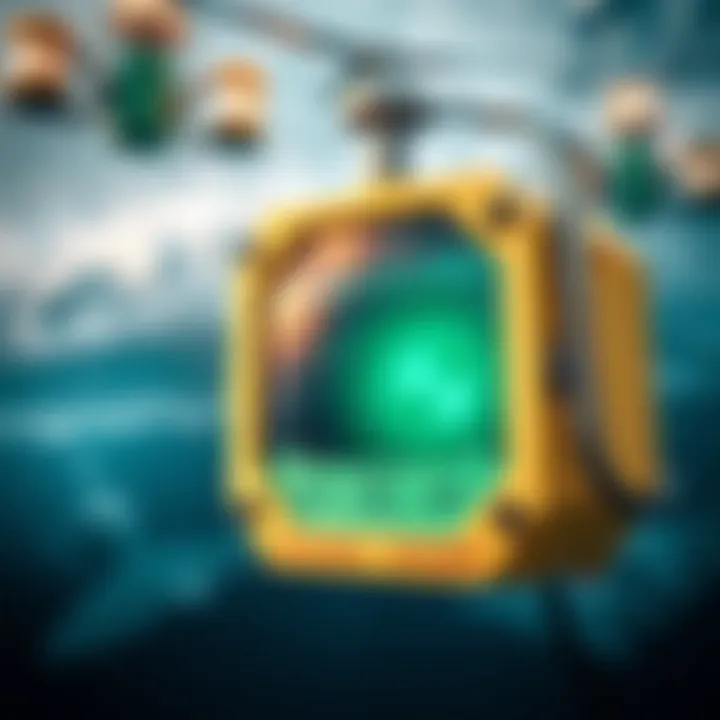
This integration of shark radar technology and education addresses two distinct yet interlinked components: safety and awareness. When surfers know the technology's capabilities and understand shark behavior, it not only enhances personal safety but also contributes to a more profound appreciation of marine life. Moreover, this knowledge can promote better practices, encouraging surfers to adopt measures that align with conservation efforts, such as avoiding unnecessary encounters with these marine animals.
"Shark radar technology has transformed our way of engaging with the ocean, shifting perceptions from fear to understanding."
In summary, the applications of shark radar technology in surfing are not just about monitoring the ocean for threats. They signify a leap towards fostering a culture of awareness, safety, and responsibility among surfers, ensuring that the waves can be enjoyed without compromising personal safety or marine ecosystems. As surfers embrace this innovation, the blend of technology with education becomes vital in crafting a safer surfing experience.
Challenges in Shark Detection
Shark detection is not a straightforward task, and as surfers and marine enthusiasts know, various complications make it both a science and an art. Understanding the challenges in shark detection is crucial for enhancing safety measures in ocean waters. These challenges influence the effectiveness and reliability of shark radar technology, ultimately affecting the surfing experience and safety protocols established at beaches.
Environmental Factors
Several environmental factors impact shark detection technology in profound ways. The ocean is a dynamic environment with changing conditions such as wave activity, water clarity, and weather disturbances. Each element poses distinct challenges for detecting these ocean predators effectively.
- Visibility Issues: The water’s murkiness can significantly impair detection systems. For instance, during a storm or after significant rainfall, sediment may cloud the water, making it hard for radar and sonar systems to locate sharks.
- Ocean Currents: Strong currents can disperse sharks over wide areas, complicating their tracking. When conditions are rough, sharks may not roam near the coastline, limiting radar's ability to get accurate readings or making it difficult to predict their movement patterns.
- Temperature Variations: Sharks prefer particular temperature ranges and often seek out warmer waters. Changes in ocean temperatures can lead to shifts in shark behavior, impacting how detection systems are calibrated to accurately pinpoint their locations.
Shark species adapt to these environmental shifts, creating further ambiguity for detection technologies. As a result, accurate monitoring requires adaptations to current systems to consider such variables, ensuring that safety measures stay effective.
Limitations of Current Technology
Despite advancements, current shark detection technologies are not foolproof. They face limitations that challenge their reliability and efficiency. A clear understanding of these constraints can drive researchers and developers to innovate further.
- False Positives and Negatives: Many systems, especially those that primarily rely on sonar, may lead to false alarms or missed detections. Species resembling sharks, such as large schools of fish, can trigger alerts, or conversely, a lurking shark may go undetected if it does not cross the radar's path.
- Cost and Accessibility: Advanced radar systems and their installations can be cost-prohibitive, particularly for smaller beaches or community-operated surf spots. This disparity can leave some surfers without adequate safety measures while others benefit from high-tech solutions.
- Lack of Real-Time Data: Many detection systems offer delayed information regarding shark activities. In an environment where a quick response can be life-saving, such delays are concerning, especially if surfers are unaware of an imminent threat.
The reliability of shark detection technologies hinges not just on their sophistication, but also on overcoming the inherent challenges posed by their environment.
Awareness of these limitations is essential for surfers and beachgoers. It aids in setting realistic expectations regarding the efficiency of shark radar systems and highlights the need for continuous improvement in technology and strategies to ensure ocean safety.
Future of Shark Radar Innovations
The trajectory of shark radar technology holds considerable promise for enhancing ocean safety, especially for those who engage with the surf. As the ocean remains a wild and unpredictable environment, innovations in radar technology can serve as the lifebuoy for surfers and recreational swimmers alike. So what lies ahead? Let’s dig deeper into the advancements and implications that this future holds.
Advancements in Sensor Technology
Within the realm of shark radar, sensors are the backbone. These devices have made significant strides in accuracy and range. Traditionally, shark detection relied heavily on basic sonar and simple radars. However, new sensor technologies such as multispectral imaging and acoustic sensors have made waves, quite literally.
The advantages of these advancements are manifold:
- Increased Detection Range: Modern sensors can detect not just sharks, but also other marine life well before they come close to shore.
- Real-Time Data Transmission: Advanced sensor technology enables immediate data relay to surf monitoring systems. This means that surfers can receive up-to-date notifications about nearby activities.
- Reduced False Positives: With the integration of advanced imaging techniques, the misidentification of harmless marine animals as sharks has significantly decreased.
Looking ahead, researchers are focusing on integrating these new technologies with existing radar systems to create a seamless web of detection capabilities. This integrated approach has the potential to revolutionize how we monitor our beaches and safeguard those who enjoy the ocean.
Integrating Artificial Intelligence
Just as radar technology has evolved, artificial intelligence is stepping onto the field, ready to change the game. By harnessing AI, shark radar systems can learn and adapt over time, something that can lead to smarter and more efficient detection methods.
The role of AI includes:
- Data Analysis: AI algorithms can sift through vast quantities of data more rapidly than humans can, identifying patterns and potential threats much quicker. This can mean the difference between safety and disaster when it comes to surfers in the water.
- Predictive Modeling: With enough historical data, AI can attempt to predict shark movements based on environmental factors, such as water temperature, currents, and baitfish presence. This could guide surfers to safer areas or times to enter the water.
- User Tailored Alerts: Imagine a future where surfers receive customized notifications based on their specific locations and preferred surfing times. AI could analyze user patterns and environmental data to suggest optimum surfing conditions, while also alerting them to nearby shark activity.
“The integration of AI into shark radar could lead to an era where surfers feel safer and more informed than ever.”
In essence, the future of shark radar innovation is not just about detecting sharks more accurately; it's about creating a comprehensive safety net for surfing communities. The combination of advanced sensor technology and artificial intelligence presents a robust solution that would ultimately enhance recreational ocean activities. As these advancements come to fruition, they will surely underline the enduring relationship between technology and our natural world.
Global Perspectives on Shark Safety
Shark safety extends beyond the boundaries of individual beaches or surf spots. It requires a global perspective, recognizing that the intricacies of marine ecosystems and human interactions with them do not follow strict borders. Various cultures and surfing destinations face their unique predicaments when it comes to shark safety, necessitating a collaboration of knowledge and practices. These global insights provide practical lessons and a framework upon which local initiatives can build. Through a combined understanding of regulations, technology usage, and educational efforts, the surfing community can enhance their overall safety while respecting marine life.


Case Studies from Popular Surfing Destinations
Examining shark safety practices across different regions paints a vivid picture of how localities deal with similar challenges but in uniquely tailored ways.
- Australia's Shark Monitoring Network: In Australia, the SharkSmart program includes beach safety and awareness initiatives that help surfers stay informed. The program uses technology, like aerial surveillance and sonar systems, to monitor sharks in real time. By providing users with mobile alerts, it ensures that surfers are aware of nearby shark activities.
- Hawaii's Cultural Approach: Hawaii presents an interesting case with its deep-rooted cultural beliefs about the ocean. Local practices involve invoking respect for sea creatures through educational programs that highlight sharks' ecological roles. Initiatives like the 'Sharks in Hawai'i' program educate the public about coexistence with sharks while referencing historical interactions, creating a balance between safety and cultural heritage.
- California's Response Plans: California surfers benefit from technology-driven safety plans that employ drone surveillance and automated detection systems. This state is notable for its proactive communication strategies, which relay shark sightings to local communities instantly, allowing surfers to adjust their activities in real-time.
By reviewing these case studies, we can uncover common threads that promote shark safety, blending technology and education while respecting local cultural contexts.
International Regulations and Guidelines
On a broader scale, international regulations and guidelines play a significant role in shaping shark safety protocols worldwide. Organizations such as the International Union for Conservation of Nature (IUCN) and the Convention on Migratory Species help set the framework for best practices in shark conservation and human interactions.
- United Nations Guidelines: The United Nations has established guidelines that encourage countries to implement monitoring systems for shark populations and to create conservation areas. Such measures can help prevent shark attacks by maintaining healthy ecosystems.
- Regional Agreements: Various countries have formed agreements to share data on shark movements and to enforce regulations regarding fishing practices. These agreements not only enhance research efforts but also facilitate coordinated responses to shark encounters near popular surfing destinations.
- Interagency Cooperation: Organizations like the National Oceanic and Atmospheric Administration (NOAA) in the U.S. collaborate with local governments and institutions, creating a unified approach to monitoring shark populations, conducting educational campaigns, and establishing safety protocols.
Educating surfers about these regulations can empower them to advocate for continued safety measures and ecological awareness. The intertwining of international efforts with local implementations paves the way for a comprehensive approach to shark safety, ultimately ensuring a more secure environment for those who seek adventure in the waves.
The importance of a global perspective in shark safety cannot be overstated. A combination of technology, local knowledge, and international cooperation provides a robust framework for ensuring the safety of surfers while promoting sustainable practices for marine life.
Community Involvement and Education
Community involvement and education play a pivotal role in enhancing the efficacy of shark radar technology and its relevance to ocean safety. When surfers become part of the collective effort in promoting shark safety, it fosters a shared sense of responsibility. The surf community is not just made up of individuals riding waves; it comprises people who cherish the ocean's health, biodiversity, and their own safety. Through active participation, these communities can create a dynamic feedback loop that not only informs their members but also refines the technology that helps protect them.
Local surf clubs and organizations can initiate dialogues about shark sightings and behaviors, engaging surfers actively in the conversation. This knowledge-sharing is crucial because it equips surfers with the information they need to make informed decisions while in the water.
Engaging Surf Communities
Building a robust engagement pathway with surf communities is fundamental. Opportunities abound in collaborating with local surf schools, shops, and even online forums. Grassroots efforts can yield immense benefits, such as:
- Workshops that focus on shark identification and behavior. Surfers who understand these creatures are less likely to panic at the sight of one, fostering a safer ocean environment.
- Community events like beach clean-ups, which serve a dual purpose of promoting ocean health and awareness about local marine life, including sharks.
- Surfer-led initiatives, such as buddy systems or "shark-watch" days, where members can report shark sightings in real-time, enhancing the local shark radar’s efficacy.
Collaboration with local government and conservation groups can also amplify these efforts. The potential for leveraging funding or resources can lead to technology upgrades or enhanced educational materials, providing a well-rounded approach to shark safety.
Educational Campaigns and Workshops
Educational campaigns play an integral role in demystifying the concept of sharks and their interaction with surfers. A well-informed surfer is less likely to be subjected to misconceptions. Educational workshops can tackle a variety of topics related to shark safety, such as:
- Marine Ecology: Understanding the role of sharks in ocean ecosystems can shift the narrative from fear toward appreciation.
- First-Hand Accounts: Real-life experiences from seasoned surfers can offer invaluable insights, allowing newer surfers to relate less to myths and more to reality.
- Technological Training: Familiarizing surfers with shark radar technology ensures that they are not only aware of its existence but are also adept at utilizing it. This includes how to interpret radar alerts and respond appropriately.
"Knowledge is power; a well-informed surfer can navigate the waters with confidence, knowing they are equipped with the best tools for safety."
To maximize its impact, education can leverage multiple channels such as social media platforms like Facebook, Instagram, and dedicated Reddit communities specifically focused on surf safety. Engaging surf influencers to amplify the message can reach a broader audience and generate meaningful conversations about marine life.
In summary, community involvement and education serve as the backbone of shark safety efforts. By fostering a culture of awareness, collaboration, and learning, surfers not only safeguard themselves but also contribute to a healthier ocean environment.
End
In wrapping up this exhaustive exploration of shark radar technology, several significant elements become clear. Each component discussed—ranging from the technological intricacies to real-world applications—serves as a reminder of how vital these systems are for the surfing community and broader marine safety. The integration of shark radars into everyday surfing operations doesn't just create an extra layer of protection; it fosters a culture of awareness and respect for our oceans.
Summarizing Key Insights
The insights gathered throughout this article underscore the pivotal role technology plays in enhancing safety on the water. Here are the key takeaways:
- Safety First: Shark radar systems offer surfers a robust tool against potential dangers posed by sharks, promoting safer surf environments.
- Technological Growth: Recent developments highlight the necessity for ongoing advancements in sensor technology and data processing to improve detection rates and accuracy.
- Community Education: Engaging and educating surf communities not only heightens safety but also entrusts individuals with knowledge about marine ecosystems and shark behavior.
- Global Regulations: Understanding international guidelines enhances cooperation in implementation strategies, paving the way for more standardized practices across surf destinations.
"Knowledge is power, especially in our vast oceans. By understanding the methods of shark detection, we can surf with confidence and protect our marine friends."
The Path Forward for Surfing Safety
Moving forward, it's essential for the surfing community to embrace and advocate for the continuous evolution of shark radar technology. As surfers dip their toes into the waves, they should also:
- Stay Informed: Follow current research and advancements in shark detection. Engaging with credible sources like National Oceanic and Atmospheric Administration (NOAA) or world-surfing organizations can ensure you remain up-to-date.
- Support Innovations: Encourage brands and companies pushing for new technologies that enhance safety for surfers. This not only benefits individual surfers but also bolsters the entire community.
- Promote Collaboration: Work hand-in-hand with local authorities and organizations to advocate for comprehensive shark safety protocols that integrate technological findings with practical measures.
- Engage Younger Generations: Introducing educational programs and workshops for schools near surfing locations can instill a sense of ocean stewardship in future surfers, thereby creating a safer and more informed community.
As we stand on the brink of further innovations in shark radar technology, one can only hope that the commitment to ensuring safe surfing experiences for all continues to grow. Looking ahead, the marriage of cutting-edge technology and community engagement has the potential to redefine our relationship with the ocean, making surfing a safer and more exciting endeavor.



